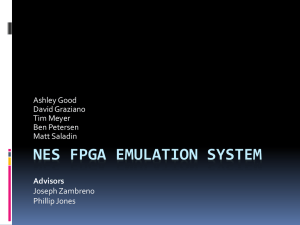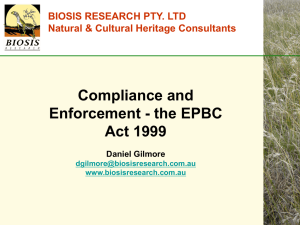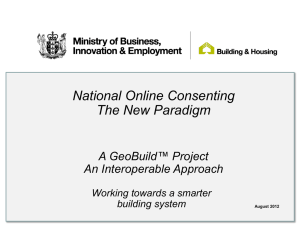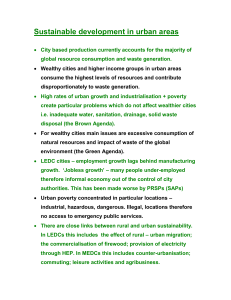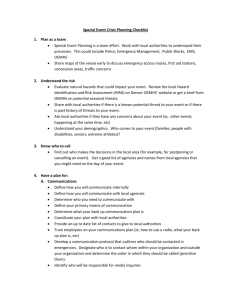HIKURANGI TAKIWA TRUST PO Box, Ruatoria 4081 Website
advertisement
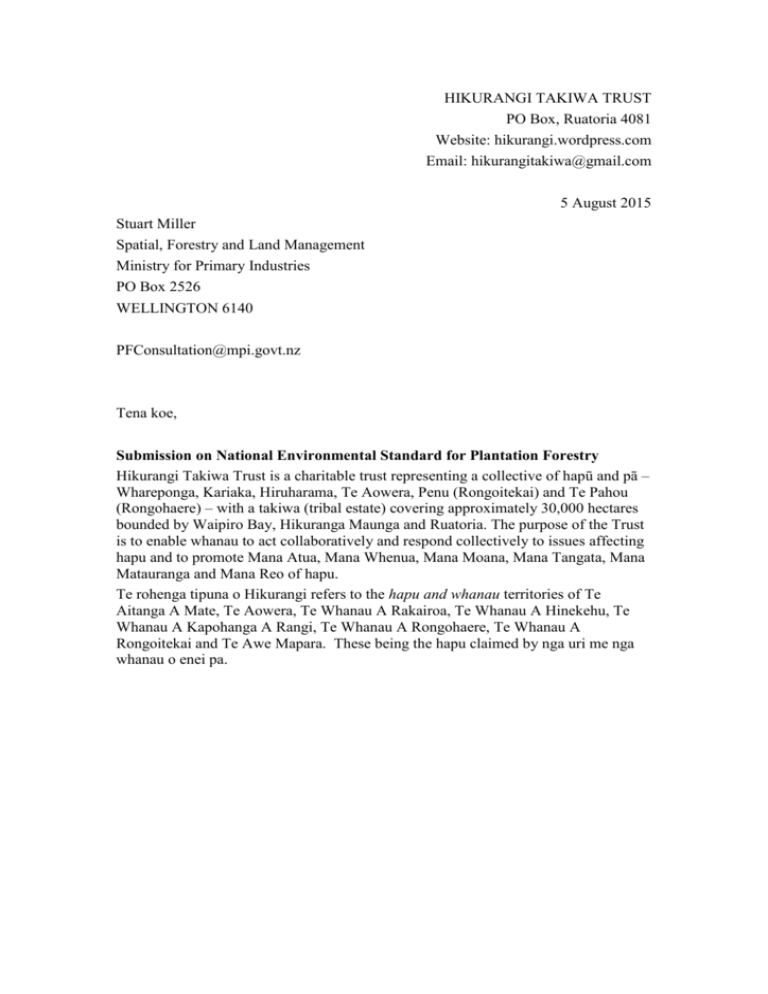
HIKURANGI TAKIWA TRUST PO Box, Ruatoria 4081 Website: hikurangi.wordpress.com Email: hikurangitakiwa@gmail.com 5 August 2015 Stuart Miller Spatial, Forestry and Land Management Ministry for Primary Industries PO Box 2526 WELLINGTON 6140 PFConsultation@mpi.govt.nz Tena koe, Submission on National Environmental Standard for Plantation Forestry Hikurangi Takiwa Trust is a charitable trust representing a collective of hapū and pā – Whareponga, Kariaka, Hiruharama, Te Aowera, Penu (Rongoitekai) and Te Pahou (Rongohaere) – with a takiwa (tribal estate) covering approximately 30,000 hectares bounded by Waipiro Bay, Hikuranga Maunga and Ruatoria. The purpose of the Trust is to enable whanau to act collaboratively and respond collectively to issues affecting hapu and to promote Mana Atua, Mana Whenua, Mana Moana, Mana Tangata, Mana Matauranga and Mana Reo of hapu. Te rohenga tipuna o Hikurangi refers to the hapu and whanau territories of Te Aitanga A Mate, Te Aowera, Te Whanau A Rakairoa, Te Whanau A Hinekehu, Te Whanau A Kapohanga A Rangi, Te Whanau A Rongohaere, Te Whanau A Rongoitekai and Te Awe Mapara. These being the hapu claimed by nga uri me nga whanau o enei pa. This submission is based on a resolution of Hikurangi Takiwa Trust passed at a meeting of the Trust at Whareponga on Sunday 2 August 2015. The resolution agreed that the Trust should make a submission in opposition to the NES for Plantation Forestry. Significant areas within our Takiwa are currently in plantation forestry, significant tracts of clear land are at risk of erosion and subject to Gisborne District Council Overlay 3A requirements to treat erosion risk with tree planting in the next ten years and other areas within the Takiwa are likely to be planted in trees intended for timber as subsidies and incentives for tree planting and wood products. Representatives of Hikurangi Takiwa Trust participated in a consultation hui held in Ruatoria in March 2015 and expressed a number of concerns related to the proposed NES as it stood then. These concerns do not appear to have been addressed in the Draft NES that submissions have been invited for. While hapū are in the process of developing capability and capacity to better participate in policy development and decision-making processes, we work closely with local authorities and a number of central government agencies including the Department of Conservation, Ministry for Primary Industries and others. In this instance we have worked with Gisborne District Council staff, share their concerns about the likely impact of the proposed Plantation Forestry NES in our Takiwa and the wider region. Based on a large number of concerns in the proposed NES we cannot support its progression and need to state the opposition of the hapu and marae that Hikurangi Takiwa Trust represent. In conjunction with Gisborne District Council, we endorse the recommendations below and advise the Crown that should the NES progress and these issues not be addressed, we reserve the right to seek remedy through the range of legal instruments available to us as Treaty of Waitangi partners with the Crown. No case made for NES Plantation forest establishment has long been an important tool for soil erosion control. Once planted in plantation forest the land remains vulnerable to disturbance, and plantation forestry on steep and erosion prone hill country involves landscape disturbance activities that can be on a large scale, unlike any other land use. Clearfell harvesting affects biodiversity and re-introduces erosion risks similar to, and in some cases more extreme than, grassland for a number of years. Existing rules in Gisborne District Council’s statutory RMA plans are adequate to manage adverse effects. They are operative rules that have been agreed by the community, including forestry interests. It is pleasing that MPI has recognised some variation between consenting authorities controls on forestry is natural due to environmental, economic, social or cultural factors. In this respect “unwarranted variations” is a better reason for an NES than previously used “inconsistencies” between plans. However the Trust considers the benefit of removing both “unwarranted variations” between plans and the opportunity for plan changes is more than offset by negative regional impacts on community inputs and environmental standards. In essence the Trust does not believe an evidential case for a Plantation Forestry NES has been made and is concerned about its impacts, for this reason we oppose the proposed NES in its entirety. Should the NES proceed, following are changes we will require to satisfy our hapū. Orange Zone Harvesting Harvesting on all of the Orange Erosion Susceptibility Class (ESC) is a permitted activity in the proposed NES. This is opposed. Orange land includes a number of Land Use Capability (LUC) units that are steep to very steep on erosion prone soft geology prone to soil slipping that removes the entire soil layer down to bedrock that is then unable to sustain trees of any type. This land is found in areas known to be “hotspots” for cyclonic storms. It is the source of woody debris that has been recently deposited onto river flats, into river channels and on beaches in large quantities. Under the District Plan harvesting requires a consenting process to give the flexibility to develop and put in place site-specific preventative and mitigation measures such as re-planting requirements. The NES permitted activity conditions are inadequate and rigid. It is unacceptable that such land is afforded permitted activity status given the risks involved. Section 43 A (3) (b) RMA 1991 does not allow an NES to state that an activity is a permitted activity if it has significant adverse effects on the environment. This is such an activity. Requested change: Include controlled or restricted discretionary status for harvesting on steep to very steep erosion prone LUC units of Orange ESC. Orange Zone Afforestation Linked to Orange ESC harvesting issues is afforestation (of new forests) on Orange being a permitted activity. This would prevent any planting restrictions as a method to mitigate woody debris from future harvesting. This is opposed. Requested change: Restricted discretionary status for afforestation on steep to very steep erosion prone LUC units of Orange ESC. Sensitive Receiving Environments The ESC classification is based on LUC which is then used to determine activity status. This is a very good process to assess risk on the sites where the forestry activities are being carried out, but takes no account of variations in downstream receiving environments which demand site specific measures to avoid or mitigate adverse effects. Where the activity status includes a resource consent requirement this imparts the flexibility to provide for differing receiving environments and this is supported for this reason. However where permitted activity status applies, supported by generic permitted activity conditions only without allowance for variations in downstream receiving environments, this is opposed. It also breaches the Section 43A (3) (b) RMA 1991 stipulation. Requested change: Inclusion of sensitive receiving environments such as estuaries, coastal marine areas, water intakes, dwellings and amenity features into the matters where Consenting Authorities can apply more stringent rules. It is noted an earlier Plantation Forestry NES proposal included an exception for sensitive receiving environments. Uncertainty of Conditions The proposed permitted activity conditions frequently use uncertain language such as “as far as is practicable”, “if unavoidable”, “except where unsafe or impracticable to do so”. Such language results in conditions that are litigious or unenforceable. A rule that is unenforceable has little effect. Use of uncertain language throughout permitted activity conditions is opposed. The NES proposal explains further analysis and drafting is envisaged and the rules as they are amount to drafting instructions. There is no obvious clear and certain language for many of the rules that would suitable manage adverse effects across all circumstances. Requested change: That if permitted activity status is retained the relevant conditions err on the side of caution, alternatively a consents regime should be required. Ability to be More Stringent The listed NES activities covered by rules encompass all major within forest activities. The ability for Consenting Authorities to be more stringent is tightly constrained. This is opposed. To properly apply sustainable management and give effect to their statutory responsibilities Consenting Authorities need the ability to be more stringent than allowed for in the NES. Mapping areas of significance is expensive and takes considerable time to collect and collate the required data. Good outcomes can be achieved through setting out key parameters and using site-specific assessments and conditions. Requested change: Unmapped wahi tapu sites, unmapped significant indigenous flora and fauna, other than outstanding but still significant freshwater bodies and natural features and landscapes (as well as sensitive receiving environments as above) all be included as matters where Consenting Authorities can apply more stringent rules. Management Plans Harvest Plans, Quarry Management Plans and Erosion and Sediment Control Plans are required to be prepared for harvesting, quarrying and earthworks respectively. These provisions are opposed in their present format. The contents required of these plans is broadly described and it is by no means certain that plans will adequately describe activities or the activities intended will be sufficient to achieve other permitted activity conditions. The role of Consenting Authorities is restricted to being advised when activities will begin and having the Plans made available to them. There is no provision for Consenting Authorities (or any other body such as iwi or hapū) to certify the Plans as adequate. Requested change: During the legal drafting phase, management plans content should be made clearer and linked to clear outcomes and provision made for Consenting Authorities certification as adequately meeting the content requirements. Mechanical Land Preparation – Root Raking Root raking is permitted in the Orange and Red Zones on slopes >25º if the activity does not affect the subsoil. This would allow the total removal of the topsoil and is opposed. Top soil removal would severely limit plant growth of any kind and is a practice not regarded as sustainable land management. Without topsoil and plant cover land is subject to soil erosion. Topsoil disturbance should be kept to a minimum. Requested change: Root raking in the Orange and Red Zones on slopes >25 0 should only be permitted if the soil A horizon is not removed. The A horizon should be defined as “the surface soil layer consisting of surface mineral horizons with maximum organic matter, usually dark in colour”. Permitted Activities The proposal, for this district would mean fewer forestry activities would be subject to resource consent processes. Instead there would be more permitted activities subject to NES permitted activity conditions. The cost of monitoring resource consent conditions is recoverable from consent holders. The cost of monitoring permitted activity conditions is not. This would amount to a shift in cost from those carrying out forestry activities to the wider community. Resource consent processes involve pre-application discussions, requiring further information and formulating clear activity based conditions that will lead to required environmental outcomes. These are proactive processes by which forestry activities are able to be shaped before they begin. They enable useful advice to be conveyed to contractors not used to local conditions. Forestry activities such as earthworks, quarrying and harvesting are irreversible and are often large in scale and happen very quickly. Where activities are permitted they are able to proceed without Consenting Authorities approval. How the activities are carried out is unable to be influenced. Consenting Authorities involvement is limited to compliance monitoring and enforcement. These are reactive in nature, occurring after activities have occurred. Requested change: Orange zone harvesting as a controlled or restricted discretionary activity; and inclusion of sensitive receiving environments as matters where Consenting Authorities can apply more stringent rules. These are areas of the NES where environmental risks are high and intensive compliance monitoring would be required. Water Quality Limits and the NPS for Freshwater Management. Many of the proposals in the draft NES cut across the NPS-FM Objectives 1 and 2, and the requirements for the Consenting Authorities to manage water quality set out in that NPS-FM. While the “Ability to be more stringent” section of the NES identifies that this is “where required to meet the Objectives of the NPS-FM”, the discussion document identifies this as where a limit has been set that has not been met, and forestry activities are the source of the contaminant. Based on this explanation, this would seem to cut across the NPS-FM requirement for Consenting Authorities to “maintain and improve” water quality – as Consenting Authorities could only be more stringent if the water quality was degraded. Limiting the ability for the Consenting Authorities to be more stringent to only where a water quality limit has been exceeded is opposed. Requested change: Consenting Authorities have the ability to be more stringent in relation to all water quality limits set in order to enable them to maintain and improve water quality as required by the NPS. Outstanding waterbodies The discussion document identifies that Consenting Authorities can be more stringent “where significant values of outstanding waterbodies have been specified and forestry activities would have an adverse effect on these values” yet the rules set a number of permitted and controlled activity rules for outstanding waterbodies – including setbacks, river crossings and installation of slash traps. This is likely to create confusion and is opposed. Requested change: Delete references to outstanding waterbodies in the rules and allow Consenting Authorities the full ability to put in place appropriate rules for activities which could affect the values of outstanding waterbodies. Wetlands The NPS-FM specifically requires the protection of the significant values of wetlands. The discussion document does not specifically identify wetlands and their riparian areas as being a matter over which Consenting Authorities can be more stringent. All of the forestry activities identified within the rule tables have the ability to affect the significant values of wetlands. For example In relation to setbacks the NES rule tables reference wetlands only greater than 2500m2. In many instances the setbacks proposed may be insufficient to protect a wetland’s significant values – for example by altering the water table. The provisions for wetlands in the NES are opposed. Requested change: That the rules in relation to wetlands are deleted in their entirety and Consenting Authorities retain the ability to be more stringent around the management of wetlands and their riparian areas across all activities. Timing of Earthworks Timing of earthworks and activity within riverbeds is a significant issue both in terms of generation of sediment and avoidance of impacts on aquatic ecosystems and riverine birdlife. No provision for an earthworks “close out” season is provided for in order to protect the values of sensitive receiving environments including outstanding waterbodies and wetlands. Requested change: Consenting Authorities have the ability to be more stringent around the timing of earthworks and activities within the bed of a river or lake in all zones where this is required to protect sensitive receiving environments. Fish Species Spawning, Migration and Riverine Birds The General Conditions provide for fish spawning but only relate to a small number of mostly non-migratory species. Only 5 of these species are found in the Gisborne region, and many are not found in the North Island. It does not include a number of nationally critical and nationally endangered species as species such as inanga which are a substantial component of the whitebait fishery. Relief sought: This list should be amended to include: long finned eel, short finned eel, short jawed kokopu, torrentfish, Crans bully, bluegill bully, upland bully, giant bully, inanga, banded kokopu, lamprey and smelt. The General Conditions list periods of time where beds of rivers cannot be disturbed in order to protect the spawning of the fish species. These dates however do not align with local spawning dates of species in different parts of New Zealand. Fish will spawn at a different time in Invercargill to Northland – or Gisborne. This renders these dates ineffective and they are opposed. Requested change: Allow Consenting Authorities to identify the local spawning times for fish species in their region through regional plans. The General Conditions do not provide for native fish migration. In the case of species such as long finned eel, barriers to downstream migration can result in the death of the tuna as they have undergone physiological change in order to undertake migration and no longer feed. Requested change: Allow Consenting Authorities to identify important migration periods for native fish in their regions and be more stringent in relation to activities in the beds of rivers during these periods. The General Conditions provide for protection of nesting sites from disturbance for Nationally Critical or Nationally Endangered species. This does not provide for regionally threatened species or stronghold populations. Requested change: Consenting Authorities are able to be more stringent where they have identified regionally threatened species or stronghold populations. Genetic Engineering The proposed NES specifies that afforestation and replanting using genetically modified tree stock would be classed as a permitted activity where approval has been granted by the Environmental Protection Authority (EPA) for the use of such organisms. This is explained as affirming the EPA’s authority to determine any risks of GMOs, and affirming that any conditions imposed by the EPA would be sufficient to ensure risks are managed. There would be no opportunity for a Consenting Authority to make its own rules, policies or conditions in relation to GM tree species in its landscapes and ecosystems. This provision contradicts the recent Environment Court decision (Federated Farmers v Northland Regional Council [2015] NZEnvC 89) where Judge Newhook found that there is jurisdiction under the RMA for regional councils to make provision for control of the use of GMOs through regional policy statements and plans. The proposal that GMO forestry would be a permitted activity could constrain Consenting Authorities ability to respond to valid future concerns about the use of GMO species (potentially for a range of reasons including environmental risk, pest management, or risks to the regional, iwi or hapu economy, brand and reputation and our ability to market our produce overseas). Requested change: Consenting Authorities continue to exercise precaution and to have the ability to set rules relating to GMO in their region. Heoi ano, ka oti o matou whakaaro. Pia Pohatu, Trustee On behalf of Hikurangi Takiwa Trust. Natasha Koia, Trustee


